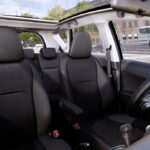Are Chrysler Good Cars? (and 2 Models to Avoid)
Design breakthroughs here, financial mishaps there, Chrysler’s long history has made it unique in the automotive market. But are their cars truly worthy of a spot in your garage?
What MPG Can You Expect from a Chrysler Car?
Using the smallest engines available, the current Chryslers reach a combined mileage of 22 MPG. The Chrysler 300 reaches a combined 23 MPG (19 city; 30 hwy) while both the Pacifica and the Voyager are good for a combined 22 MPG (19 city; 28 hwy), all of them using the 3.6-liter V6 with automatic transmission.
Adding all-wheel drive lowers the combined mileage by 2 mpg on the 300 and the Pacifica; the Voyager does not offer that option.
The 300 can also be upgraded with a 5.7-liter V8, which lowers its mileage to a combined 16 MPG.
What are the Most Common Problems with Chryslers?
Problems with engine cooling and electrical system are the most common.
Owners who had the Chrysler 300 of multiple years ever since it was first released have reported 5,825 problems with it. The most frequent ones affected the electrical system (1,339), airbags +++=(1,122), powertrain (848), and engine cooling (590).
When it comes to the Pacifica/Voyager, there is a total of 2,142 problems reported since 2017, the year when the current generation was released. Considering all Pacificas ever produced, the most common problems regard engine cooling (1,373), structure (795), powertrain (774), and electrical system (760).
The current Chrysler 300 and Pacifica/Voyager all use the same base engine, a 3.6-liter V6. That makes it easier to understand why the issues with one model and the other are so similar.
Also read: 10 Cars Under $20K that Look Like They’re for $50K+
Do Chrysler Cars Rust?
Nowadays, Chrysler cars don’t tend to rust. Those produced in the 1980s and 1990s had problems with rust, indeed.
It is widely known that generalist automakers, in general, went through a difficult phase in those years when it comes to rust: there were countless cases of body paint peeling more than expected and, eventually, succumbing to rust.
The K-cars were a notable example of that, but it is also possible to mention newer Chrysler cars becoming prone to rust, such as the LHS.
Are Chrysler Cars Safe?
Both the 300 and the Pacifica boast long lists of standard safety items. For example, the Pacifica offers many electronic assistance items, some of them typically found only on more expensive models. Some concern active protection like automatic emergency braking to protect pedestrians, while others focus on everyday situations such as park assist and adaptive cruise control.
The 300 has been updated in this regard over the years, of course, but the fact that it is a much older model makes it simply comply with the standard of its category rather than stand out.
Trending Video: How to Easily Bring Back to Life any Old Car Battery and Save Tons of Money (click to watch)
Do Chrysler Cars Hold Their Value Well?
In the first year, the models currently on sale hold 78.1% on average. The Chrysler 300 holds 77.9% of its value after the first year, then 44.3% after five years, and 24.9% after ten years. The Pacifica holds 78.2% of its value after the first year and is estimated to hold 45.3% after five years and 30% after ten years – the current generation was released in 2017.
The Voyager holds 78.2% of its value after the first year and is estimated to hold 45.3% after five years and 27.3% after ten years – the current generation was released in 2020.
Also read: Do Classic Cars Have Airbags? Can You Install Them?
How Good is Interior Quality in Chrysler Cars?
The quality of interior in Chryslers has improved over the years, but not yet enough to match the market standards. The brand uses lots of cheap plastic and texture that breaks easily.
Chrysler traded hands many times over the past decades because of its troubled financial situation. Such a history gave each owner little time to properly invest in restructuring departments such as quality control. Besides that, there were times when making Chryslers more refined and reliable was simply not in the interest of its parent company.
After spending a long time with the reputation of low build quality which even resisted the Fiat takeover at first, the Stellantis era seems to be interested in taking better care of Chryslers in that regard. The most common issue nowadays is the excessive use of cheap plastic parts, often shared among several models.
Even though it is cost-efficient, that solution lowers perceived quality. The materials used in the cabin have a subpar appearance and texture and tend to break easily, so the cars end up with small but frequent issues.
How Much Does it Cost to Maintain a Chrysler Car?
In the first year, the current models average at $ 325.
The Chrysler 300 costs an average of $272 in the first year, $2,071 over the first five years, and $7,739 over ten years.
The Chrysler Pacifica costs an average of $ 366 in the first year, $ 2,816 over the first five years, and $ 10,620 over ten years.
The Chrysler Voyager has slightly lower costs than its luxury counterpart: $338, $2,677, and $10,342 respectively.
Also read: Are German Cars Expensive to Maintain? How Exactly?
What are the Most Reliable Chrysler Models?
Both models currently available, the 300 and the Pacifica, are quite reliable.
The fact that the 300’s current generation has been on sale for so many years makes it gradually less competitive against direct rivals in many aspects, but reliability is the exception: it only proves that it has a good project, indeed.
It was originally developed with Mercedes-Benz bits inherited from the DaimlerChrysler era, then further improved once the Fiat group took over. A platform good enough to underpin performance-oriented Charger and Challenger siblings could only do even better with the urban sibling.
When it comes to the Pacifica, it seems that everything was done right. Even the redesigned model has already been extensively tested by the specialized press, and the results are quite favorable. Complaints are often focused on low trim quality, not problems that would leave you stranded.
The Voyager is the third name on Chrysler’s current line-up, but it is just a pre-facelift Pacifica focused on entry-level versions designed to replace the Dodge Grand Caravan. Most of the upscale sibling’s qualities can be mentioned again here.
Which Chrysler Models Should You Avoid?
Having the previous topic in mind, only the discontinued Chryslers demand caution.
Models designed in the DaimlerChrysler era, like the Crossfire and the first-generation Pacifica, were plagued by the low build quality. The Neon came earlier than that but was an entry-level car, so there was no budget to make it different. Time has only made it more and more recommendable to avoid those cars.
Moving on to more recent models, the second-generation Sebring (which eventually became the first-generation 200) and the Aspen did little to dissolve that bad image. The Fiat ownership made the 200 much more beautiful on the second generation, but that was the only big improvement; low build quality, and cheap and numerous plastic parts have harmed these cars’s reliability.
Finally, specific recommendations in this regard are the Crossfire and the Aspen. The first one was an attempt to participate in a niche market while the other was a badge-engineered version of the Dodge Durango, but neither lasted long in the market. While they are excellent for car enthusiasts and/or collectors, the limited availability of spare parts makes them Chrysler options to avoid.
What are the Best Alternatives for Chrysler?
Japanese cars have a reputation of being good in aspects where Chryslers have been failing.
The previous topics show that Chrysler’s most serious problem is build quality; it is the origin of the use of cheap plastic parts, the subsequent high chances of those parts breaking, the peeling of the body paint, and the tendency to rust.
Japanese cars, on the other hand, are famous for their overall resistance throughout the years. Nowadays, competitors like Honda, Nissan and Toyota not only that quality but also much larger model line-ups, which means they are more prepared to cater to different customer profiles.






